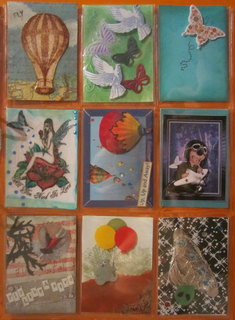Artists Trading Cards or ATCs for new Zealand Artists
Unleash Your Creativity and Connect with Artists: Exploring the World of Artist's Trading Cards (ATCs)
I was captivated when I first discovered the world of Artist's Trading Cards or ATCs. These miniature works of art intrigued me with their unique concept and potential for creative exchange. If you have yet to hear of ATCs, let me take you on a journey into this fascinating realm.
What Are ATCs?
ATCs are small, pocket-sized artworks measuring 2 ½" x 3 ½" (6.4cm x 8.9cm), about the size of a regular playing card. The idea behind ATCs is simple yet powerful: artists create these cards and trade them with other artists. It's a delightful way to engage with fellow creators, share ideas, and build connections within the artistic community.
One of the intriguing aspects of ATCs is that they are not meant to be miniature masterpieces. While some effort is expected in their creation, they are designed to be freely swapped with others. This approach allows artists to explore and experiment without the pressure of creating perfect or highly detailed artwork. Some groups even encourage artists to cover their cards, placing them in envelopes, creating an element of surprise when trading.
Its About Networking
ATCs provide a fantastic platform for visual artists to network and engage with one another. Instead of standing around at art events or gatherings, wondering what to say, you can showcase your collection of pocket-sized artwork and initiate conversations about techniques, inspirations, and artistic concepts. It's an opportunity to connect on a deeper level, fostering creative discussions and forging meaningful connections with fellow artists.
Where To Go
To dive into the world of ATCs, numerous online platforms and communities are dedicated to this art form. One such forum is artist-trading-cards.ch, the original site that offers a wealth of information, resources, and a vibrant community of ATC enthusiasts. In addition, it serves as a hub where you can explore inspiring artwork, participate in discussions, and even find trading partners.
The creative possibilities with ATCs are virtually limitless. Artists can use any medium or technique to bring their vision to life, whether it's painting, drawing, collage, mixed media, or even digital art. The only constraint is the size of the card itself. The compact canvas challenges artists to distil their ideas and artistic expression within this small space, resulting in unique and captivating artworks.
When creating an ATC, the front of the card is dedicated to showcasing your original artwork. It can be a one-off creation, part of a series, or even a limited edition. On the back of the card, you include your name, contact details, the title of the ATC, and, optionally, the edition number for limited editions. It's a way to leave your artistic imprint and allow others to connect with you beyond the visual experience of the artwork.
Trading ATCs is a dynamic process that offers flexibility and personalisation. You can decide whom you trade with and how you approach the exchange. Whether you opt for a one-to-one trade, swapping one of your cards for someone else's or prefer a more elaborate arrangement, the choice is yours. Some artists even trade multiple cards, considering specific designs or themes more valuable. The ultimate goal is to foster creativity and communicate through art, creating a vibrant network of artistic expression.
While face-to-face trading sessions are often preferred, enabling artists to meet in person and build connections, postal trading is also standard. In this digital age, artists worldwide can engage in ATC exchanges, transcending geographical boundaries and cultural differences. It's an incredible opportunity to explore diverse artistic perspectives and styles, enriching your own creative journey.
ATCs and ACEOs
It's worth mentioning that there is a distinction between ATCs and ACEOs (Art Cards, Editions, and Originals). ACEOs are ATCs created to sell them, often through platforms like eBay. The debate surrounding the sale of ATCs versus their pure trading nature is a topic that sparks discussions within the ATC community. As a newcomer, you must familiarise yourself with the community guidelines and etiquette to navigate this aspect of ATC culture.
To delve deeper into the world of ATCs, Facebook groups provide a thriving community of artists eager to share their experiences, knowledge, and artwork. One such recommended group is "ATCpage" on Facebook, where you can connect with fellow ATC enthusiasts, participate in swaps, and gain inspiration from the vibrant community.
If you're interested in creating your own ATCs but need help figuring out where to start, various resources and tutorials are available to guide you. Websites like wikihow.com and altered-art.net offer step-by-step instructions, tips, and techniques to help you confidently embark on your ATC journey. These resources cover everything from materials and composition to techniques and design elements, empowering you to unleash your creativity and produce captivating ATCs.
At the End of the Day
ATCs provide an excellent avenue for artists to express themselves, connect with others, and expand their artistic horizons. By exchanging these miniature artworks, you engage in creative conversation, inspiring and being inspired by the diverse talents within the ATC community. So, embrace the rules of ATCs: create original artwork within the designated size, participate in trades rather than sales, and let your imagination run wild. Join this vibrant world of Artist's Trading Cards and embark on an exciting journey of artistic exploration and connection.
Read my article on How to Save Money as an Artist
Posted: Monday 27 September 2010
